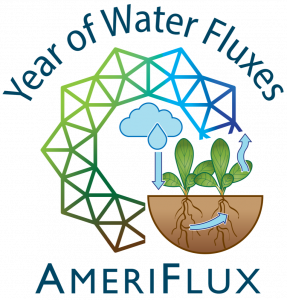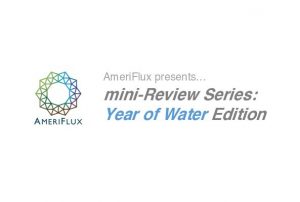 We are launching the Year of Water Fluxes as our next Theme Year for Community action. There are many science opportunities to study water fluxes in AmeriFlux. We want to support more water cycle measurements, enhance data quality, and build strong collaborations to work on the various aspects of water and fluxes.
We are launching the Year of Water Fluxes as our next Theme Year for Community action. There are many science opportunities to study water fluxes in AmeriFlux. We want to support more water cycle measurements, enhance data quality, and build strong collaborations to work on the various aspects of water and fluxes.
This effort will be led by the AmeriFlux community and supported by the AmeriFlux Management Project.
Thanks to everyone who joined our Community Meeting on March 1, 9 AM Pacific Time, to get involved, propose relevant projects, find collaborators or join a project.
If you missed it, rewatch the meeting on our Youtube channel.
Contact us to get involved!
Please contact the chairs of the Year of Water Fluxes Organizing Committee if you want to get involved. See a list of opportunities below or propose your own!
Many Potential Science Themes
Potential Science Themes for this theme year could be Land and Water Management, Coupled Carbon and Water Cycles, Remote Sensing, and Boundary Layer Dynamics.

Images: Top left: Soybeans show the effect of the drought near Navasota, TX on Aug. 23, 2013, USDA photo by Bob Nichols; Top right: USGS Evapotranspiration graphic; Bottom left: Sentinel-1B, Rendering by Pierre Carril, ESA; Bottom right: Clouds by John Knowles.
You, the Researcher, in Action
Depending on interest or opportunity, there are many potential initiatives. The list below is just the beginning. We welcome your ideas!
-
Special issue across 5 AGU journals: “Advances in scaling and modeling of land-atmosphere interactions”;
- Contribute manuscript to call for Student-Led Research in Atmospheric Science in atmosphere;
- Join our upcoming working group on teaching materials;
- Special issue in Agricultural and Forest Meteorology: Integrating surface flux and atmospheric boundary layer measurements;
- Consider submitting an abstract to one of the many relevant sessions at the AGU Fall Meeting 2021;
-
Potential other special issues of Ag and Forest Met or other journal;
-
Survey sensor needs and working with AMP to get funding to supply water table depth sensors (etc) to sites;
-
ET synthesis workshop and analyses;
-
New links or data comparisons between AmeriFlux data/sites and NASA sensor(s);
-
Special sessions at AGU, AMS, AmeriFlux or other annual meetings;
-
Develop best practices documents for water cycle measurements;
-
Speaker series on specific topic;
-
Outreach (about AmeriFlux data and resources) to USDA, Ag groups, watershed managers/water utilities, policy makers;
-
Education module for environmental engineering students, including at minority serving colleges;
-
Participate in land-water interactions workshop;
-
Conduct research as part of the upcoming DOE ARM SEUS campaign (land-atmosphere interactions). See www.arm.gov.





